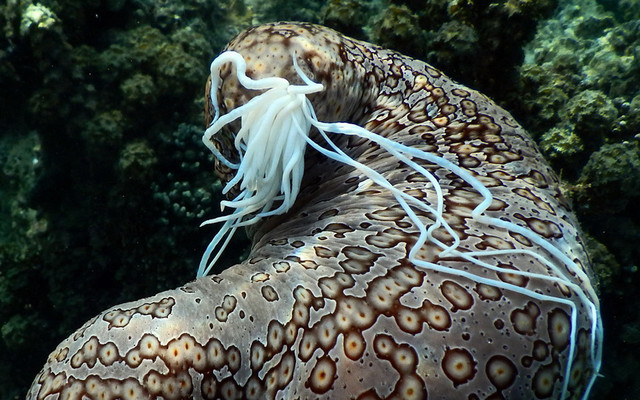Limited commercial collection of sea cucumbers — the subject of two mass harvests earlier this year — will be considered today by the state Board of Land and Natural Resources.
But some observers maintain a complete ban should remain in place to protect the seafloor dwellers, valued as food and as a medicinal extract in Asia.
PROPOSED NEW RULES
>> Annual harvesting season for waters off Oahu only
>> Commercial harvesting limited to Holothuria hilla and Holothuria edulis
>> Aquarium permit and valid commercial marine license required for up to 20 sea cucumbers per day
>> Annual catch limit of 3,600 for commercial aquarium purposes
>> Daily bag limit of five per day for personal use or consumption |
In the aftermath of the mass harvesting in June, a Waimanalo fisherman reported being unable to find a single sea cucumber in the same area in October, said Kukana Kama-Toth, a spokeswoman for Na Kua ‘Aina o Waimanalo.
The state should not consider allowing any commercial harvesting until a study is done to assess whether there’s been any recovery from the mass harvests off Maui and Waimanalo, she said.
“I don’t think our ecosystem is made for this,” Kama-Toth said.
Under the proposed rule, licensed commercial aquarium collectors with valid aquarium permits and marine licenses may harvest two species of sea cucumbers from Oahu waters only.
The species include Holothuria hilla, commonly known as “tiger tail,” and Holothuria edulis, also known as “hot dog” or “pink and black” sea cucumber. Collectors may take up to 20 sea cucumbers daily during harvest season.
An annual harvest limit of 3,600 sea cucumbers would be set for the Hawaii fishing industry. Also, the proposed rule would allow an individual to harvest up to 10 “namako” sea cucumbers per day.
In May, thousands of sea cucumbers were harvested off Maui in a commercial operation that state aquatics officials said was exporting the animals to Hong Kong. In June, massive quantities of sea cucumbers were harvested off Waimanalo, with enforcement officers saying there was no rule to limit or stop it.
At that time, Alton Miyasaka, acting administrator of the Division of Aquatic Resources, said, “We’ve never seen this extent of exploitation in Hawaii.”
In the wake of the incidents, a 120-day emergency ban on commercial harvesting went into effect June 26 as state officials worked on new rules for the long-term protection of the leathery-skinned echinoderms.
“We took the unusual step … to immediately stop the continued depletion of this natural resource,” Department of Land and Natural Resources Director Suzanne Case said in a news release. “This decision was further confirmed to be prudent when people across the state expressed outrage after seeing photographs and learning about the mass commercial harvesting of sea cucumbers in near-shore waters on Maui and Oahu.”
Sea cucumbers play an important role in the ecology of the ocean, state officials said, cleaning debris and tilling the ocean floor to keep the seabed aerated and prevent algae from developing into a dense mat.
“They’re important in the ecology of the reefs,” said Bruce Anderson, state aquatics division administrator.
While sea cucumbers are not a popular food item in Hawaii restaurants, they continue to be in demand in soups and traditional medicines in Asian countries, including China and Japan.
State officials said the recent export of the sea cucumbers was for medicinal purposes. They are cut and dried, then pounded into a powder to be put in a pill that some say relieves inflammation and arthritis, helps to reduce cholesterol and is used as an antiseptic.
The board will meet to consider the rules beginning at 9 a.m. at the Kalanimoku Building, 1151 Punchbowl St.

